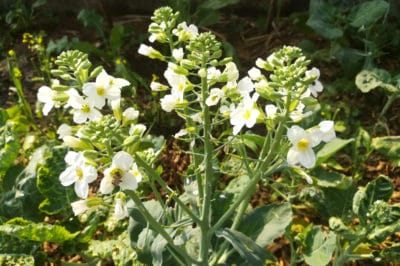When Kale Bolts
Kale is a cold weather crop that can even be planted in late summer for harvesting in the fall. It bolts during warmer weather after experiencing a period of winter’s freezing temperatures.
If the weather warms up quickly in the spring, kale can bolt much sooner than you might expect.
Your kale might not even wait until spring to bolt, though. If there is a period of thawing and much warmer weather in the middle of winter, it can trick your kale into acting as if winter is over and spring has arrived. It may begin preparing to flower in the middle of January or February.
The Signs of Bolting
Throughout the growing season, kale leaves normally grow in a ground-level cluster near the base of the central stalk. When the weather warms up, watch that central stalk for these signs that your kale is preparing to bolt:
- The stalk begins to shoot up taller.
- The leaves begin branching out from the stalk at some distance above the cluster.
- The central stalk shoots up well above the cluster of leaves at its base.
All of these are signs that your kale is about to produce flowers and then go to seed.
When Kale Goes to Seed
Two things can happen to kale to cause its leaves to become tougher and to develop a stronger, more bitter flavor:
- The temperature can go higher than 80°F (27°C) in the summer.
- The kale can flower and begin to produce seeds.
People, animals, and plants use the edible parts of plants for the same thing – nourishment. Plants store nutrients in their edible parts to draw upon when the plant is stressed or when it begins to produce flowers and seeds. So, for most plants, seed production causes a deterioration in the taste and texture of the part of the plant that we people want to eat.
What to Do With the Leaves if You Think Your Kale Is Bolting
If you think your kale is bolting, pick the leaves as soon as you can so that you have them harvested before the flavor and texture change too much. Massaging the leaves can restore some of the sweetness that might have been lost.
If you have more leaves than you can use for one meal, place them loosely in a plastic bag in the dehumidifier drawer of your refrigerator. You can keep them for about a week that way. You can also make kale chips for snacking by taking the chip-sized leaves, seasoning them, and broiling them in your oven for a few minutes, a very few minutes, until they are nice and crispy.
If you have a significant amount of kale, you can dry it in a dehydrator or your oven, and keep it as chunks to add to your dishes, crumbles to garnish or flavor your dishes, or a powder to season your dishes or to add to smoothies.
What to Do With the Kale Flowers After Kale Has Bolted
You could wait until the flowers appear and use them in a flower arrangement to decorate your table. You could also wait a little longer, until the seeds have formed and ripened, and then harvest your own kale seeds.
You could, though, watch for the florets to appear at the intersection of the leaf and the stalk, snap them off, and serve them on your table to eat. Saute them in olive oil, sear them, roast them, steam them, or stir fry them. Kale florets combine well with Asian black bean sauce, ginger, garlic, lemon, capers, or chili. Blanch the florets if they are too tough or the flavor is too strong.
